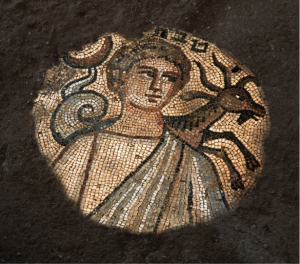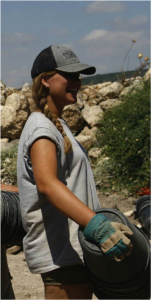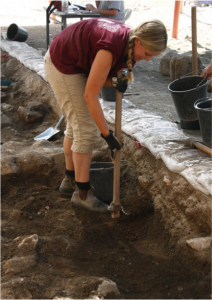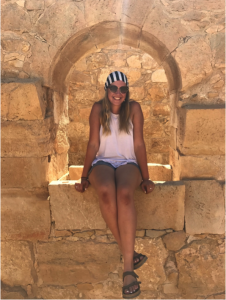
FROM JONAH AND THE WHALE TO THE SUN GOD HELIOS: EXCAVATING AT HUQOQ 2017
Emma Kerr, Strange and Midkiff Families Excavation Fellowship Recipient
“Everyone stop what you’re doing and come look at some mosaics!” The most exciting words (other than the daily call for breakfast) to hear from our dig director,UNC’s Dr. Jodi Magness, as we knew that we were about to witness something incredible. This was my third year working as part of the Huqoq Excavation Project in the Galilee region of northern Israel. My personal research is focused on earlier periods in the region, such as social and geographic networks in the Bronze and Iron ages, so one might wonder why I have chosen to spend my summers at a site whose research questions are centered on a 5th century C.E. settlement. When I was initially looking for an excavation to join for the field credit portion of my degree, I knew that I wanted to primarily work in Israel, and my university was involved in the Huqoq consortium. So, I set aside my date preferences and decided to branch out and join the team. This is one of the best choices that I’ve made, as I proceeded to learn a huge amount about archaeological methods and practice, meet and learn from a variety of amazing volunteers, staff and specialists, and be involved in fantastic discoveries. I am incredibly appreciative to ASOR and the Strange and Midkiff families for supporting my third season on the project.
Since 2012, Jodi Magness’ team at Huqoq has continuously exposed exceptionally diverse mosaics. There has been a fascinating combination of panels depicting both Biblical scenes (such as Samson carrying the gates of Gaza and Noah’s Ark) as well as Greco-Roman elements (such as cupids and winged personifications of the seasons). This year was no exception, as we uncovered everything from a panel depicting the Biblical story of Jonah being swallowed by a whale (or rather, multiple fish) to Greco-Roman sun god Helios surrounded by personifications of the months and signs of the zodiac.

Part of the zodiac panel (Capricorn) from the Huqoq synagogue mosaic (photo courtesy of Jim Haberman)
Working on the site has given me a newfound appreciation for classical archaeology, but has also pushed me to learn about many different periods, from modern to ancient. It is easy to overlook the importance of more recent layers of material culture when seeking answers to questions about the early periods, but I have loved the aspect of Huqoq that involves researching not only the Late Roman-Byzantine mosaics, but also finds like glass bottles and metal locks from the modern level of occupation (the Arab village of Yakuk, which was abandoned in the 1940s and later destroyed). It is crucial to thoroughly document and research the archaeological record in its entirety, and although one hundred years ago may not seem thrilling compared to thousands, there is so much to glean from the materials left behind in every level of occupation on the site.
Another unique aspect of the Huqoq team and project is the emphasis on collective learning and travel as a group. We have gone on several remarkable field trips over the past few years, from visiting local synagogues and exploring the Roman city of Jerash in Jordan, to swimming in the Mediterranean and riding camels in the desert near the Nabataean city of Mamshit. Unforgettable experiences with amazing people who have come to be some of my closest friends and colleagues.
Working at Huqoq has been integral to my growth as a student and archaeologist, and I am unendingly grateful to ASOR and the Strange and Midkiff families for their generous support of my time on the project this year. Thanks to this funding, I was afforded the opportunity to learn more than I thought possible about archaeological methodology and research, help to uncover stunning materials from the past, and work with an
incredible and diverse team of staff and students. Additionally, my work at Huqoq has solidified my intent to continue in the field of archaeology, helping towards my pursuit of graduate studies which will start in the fall. I cannot thank ASOR enough for supporting my travels this summer, and I hope that I can, in some capacity, return the favor one day!
Emma Kerr is a recent graduate of the University of Toronto, having received a specialist degree in archaeology as well as minors in Near and Middle Eastern civilizations and GIS. She has been involved with the Huqoq Excavation Project for the past three seasons, and will be pursuing graduate studies in Near Eastern archaeology starting in the fall.


